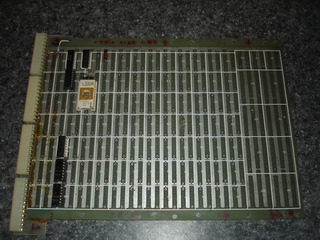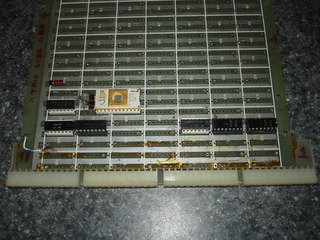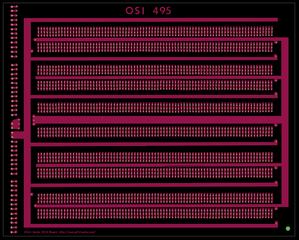Topic: Making new OSI 495 Prototype Boards
Date: 2016 APR 22
Since acquiring my Challenger III I’d wanted to find a prototype board for the OSI bus. Having a protoboard would let me build a debug board as I had for the S-100 bus, to assist in repairing the nonworking boards left over from the combination of my Challenger III boards with those that my boss had. I could also build a more reliable 48K + 8K all-in-one RAM board using a modern high density static RAM rather than a pile of SEMI4200 static RAMs. Unfortunately, original Ohio Scientific 495 prototype boards are hard to come by – I know of one other original in existence (also being used as a RAM board!), and Mark Csele had remarked in an email that they were probably unobtainable.
Additionally, 8x10” or larger sheets of perfboard or even punchboard are expensive. They don’t have pads for the Molex KK-156 connectors used with the OSI bus, and the high insertion force of the KK-156 connectors had resulted in ripped-off connectors on a previous attempt to epoxy connectors to a large piece of perfboard.
A lack of 495 boards resulted in vintage solutions like this:
This is a vintage homebrew ROM board I picked up from a popular online auction site. As you can see, a small single-sided board was hand etched to carry the KK-156 connectors, which was then glued to a large chunk of prototype board. Unlike my attempt, this one appears to hold on pretty solidly. I was thinking about replicating the small carrier board when I came across an actual OSI 495 board for sale:

It was in good condition with very little of the prototype space used – it appears the previous owner never got past laying down sockets and some basic wiring. My plan was originally to turn this into a combination debug/RAM board, but in talking with Grant Stockley about duplication of S-100 boards, I decided to instead clone the board. I used Grant’s recommendation of scanning services from Mile High Test Services, a Colorado-based shop specializing in high resolution conversion of PC board art into CAD files.
My board went off to Mile High Test Services and was scanned as a single-sided job. I specified no clean-up, to preserve the original “look and feel” of a board laid out with tape and acetate: not all lines are perfectly straight, holes are off-center, et c. I received a set of Gerber files, which I was able to manipulate with KiCad and re-export as Gerber files:
This worked out pretty well, and the board went off to the manufacturer for a small prototype run. I ran the board as single-sided, no plated-through holes, no solder mask, no silkscreen – just like the original. I did add a bit of text in the bottom-left corner indicating that the board was a reproduction:
Aside from one small flaw in a power trace (doesn’t affect functionality), it turned out great! I ran a small number of these boards as a test. So far, there hasn’t been a lot of interest in doing a larger run; however, if you’d like to purchase one of the initial boards or put your name in for a purchase on a larger run, let me know via the contact form.
chunks of protoboard




